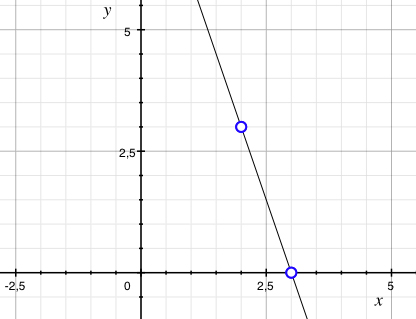Solution 2.2:5a
From Förberedande kurs i matematik 1
m (Lösning 2.2:5a moved to Solution 2.2:5a: Robot: moved page) |
|||
| Line 1: | Line 1: | ||
| + | Let's write down the equation for a straight line as | ||
| + | |||
| + | |||
| + | <math>y=kx+m</math> | ||
| + | |||
| + | |||
| + | where | ||
| + | <math>k</math> | ||
| + | and | ||
| + | <math>m</math> | ||
| + | are constants which we shall determine. | ||
| + | |||
| + | Since the points | ||
| + | <math>\left( 2 \right., \left. 3 \right)</math> | ||
| + | and | ||
| + | <math>\left( 3 \right., \left. 0 \right)</math> | ||
| + | should lie on the line, they must also satisfy the equation of the line, | ||
| + | |||
| + | |||
| + | <math>3=k\centerdot 2+m</math> | ||
| + | and | ||
| + | <math>0=k\centerdot 3+m</math> | ||
| + | |||
| + | |||
| + | If we take the difference between the equations, | ||
| + | <math>m</math> | ||
| + | disappears and we can work out the gradient | ||
| + | <math>k</math>, | ||
| + | |||
| + | |||
| + | <math>3-0=k\centerdot 2+m-\left( k\centerdot 3+m \right)</math> | ||
| + | |||
| + | |||
| + | <math>3=-k</math> | ||
| + | |||
| + | Substituting this into the equation | ||
| + | <math>0=k\centerdot 3+m</math> | ||
| + | then gives us a value for | ||
| + | <math>m</math>, | ||
| + | |||
| + | |||
| + | <math>m=-3k=-3\centerdot \left( -3 \right)=9</math> | ||
| + | |||
| + | |||
| + | The equation of the line is thus | ||
| + | <math>y=-3x+9</math>. | ||
| + | |||
| + | |||
| + | |||
| + | NOTE: To be completely certain that we have calculated correctly, we check that the points | ||
| + | <math>\left( 2 \right., \left. 3 \right)</math> | ||
| + | and | ||
| + | <math>\left( 3 \right., \left. 0 \right)</math> | ||
| + | satisfy the equation of the line: | ||
| + | |||
| + | <math>\left( x \right., \left. y \right)=\left( 2 \right., \left. 3 \right)</math>: LHS= | ||
| + | <math>3</math> | ||
| + | and RHS= | ||
| + | <math>-3\centerdot 2+9=3</math> | ||
| + | |||
| + | |||
| + | <math>\left( x \right., \left. y \right)=\left( 3 \right., \left. 0 \right)</math>: LHS= | ||
| + | <math>0</math> | ||
| + | and LHS= | ||
| + | <math>-3\centerdot 3+9=0</math> | ||
| + | |||
| + | |||
| + | |||
{{NAVCONTENT_START}} | {{NAVCONTENT_START}} | ||
<!--<center> [[Image:2_2_5a-1(2).gif]] </center>--> | <!--<center> [[Image:2_2_5a-1(2).gif]] </center>--> | ||
Revision as of 09:02, 18 September 2008
Let's write down the equation for a straight line as
\displaystyle y=kx+m
where
\displaystyle k
and
\displaystyle m
are constants which we shall determine.
Since the points \displaystyle \left( 2 \right., \left. 3 \right) and \displaystyle \left( 3 \right., \left. 0 \right) should lie on the line, they must also satisfy the equation of the line,
\displaystyle 3=k\centerdot 2+m
and
\displaystyle 0=k\centerdot 3+m
If we take the difference between the equations,
\displaystyle m
disappears and we can work out the gradient
\displaystyle k,
\displaystyle 3-0=k\centerdot 2+m-\left( k\centerdot 3+m \right)
\displaystyle 3=-k
Substituting this into the equation \displaystyle 0=k\centerdot 3+m then gives us a value for \displaystyle m,
\displaystyle m=-3k=-3\centerdot \left( -3 \right)=9
The equation of the line is thus
\displaystyle y=-3x+9.
NOTE: To be completely certain that we have calculated correctly, we check that the points \displaystyle \left( 2 \right., \left. 3 \right) and \displaystyle \left( 3 \right., \left. 0 \right) satisfy the equation of the line:
\displaystyle \left( x \right., \left. y \right)=\left( 2 \right., \left. 3 \right): LHS= \displaystyle 3 and RHS= \displaystyle -3\centerdot 2+9=3
\displaystyle \left( x \right., \left. y \right)=\left( 3 \right., \left. 0 \right): LHS=
\displaystyle 0
and LHS=
\displaystyle -3\centerdot 3+9=0

